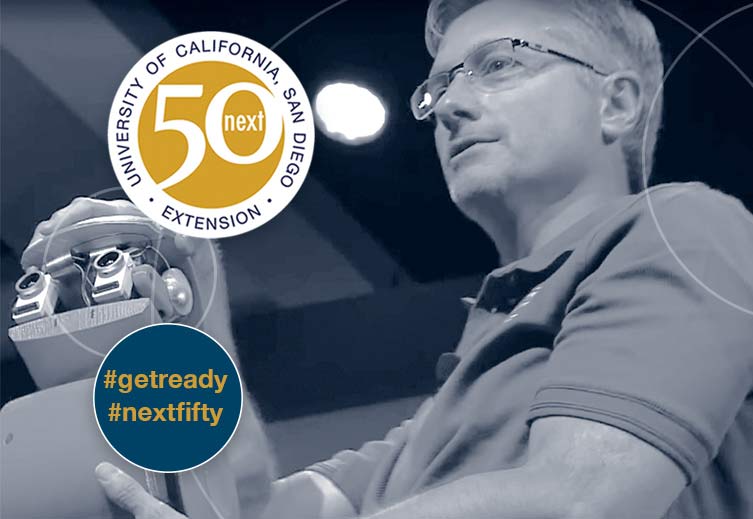13 December 2016
50 Voices of the Future: Todd Hylton on the rise of robotics

In honor of UC San Diego Extension’s first 50 years, 50 Voices of the Future asks thought leaders about the trends, breakthroughs and social advances they foresee over the next 50 years.
San Diego has the potential to become what scientist Todd Hylton calls “Robot Valley.” Hylton, executive director of UC San Diego’s Contextual Robotics Institute, believes the region has all the ingredients to become the nation’s leader in robotic innovations: great universities, a critical mass of private researchers and a fantastic location. Hylton has been working in robotics and related technologies for many years – most recently at the San Diego startup Brain Corporation and the Defense Advanced Research Projects Agency (DARPA) before that. He predicts dramatic near-term advances in the way robots impact our daily lives, from how we drive to how we maintain our health. One day, he says, there might even be a widespread demand for so-called “humanoids” – robots that look like people. How humans might respond to a world filled with humanoids is, of course, anyone’s guess. “If the robot is not too human, people like it,” Hylton says. “If the robot is very, very human, people like it. If it’s in-between, it seems creepy.”
Why is the work you do important?
There are lots of practical needs in which robots or intelligent machines could make a big difference. Consider just the example of health care. As people get older, we’d like to help prevent falls. Having a house that’s smart enough turn on the lights for you, a walker that’s smart enough to come to you and tell you when you’re about to step over something, a machine that can look at the way you’re walking and try to anticipate that you might be having problems and alert caregivers or medical personnel – all of these things seem within our grasp but they’re not yet available.
What are the influential/exciting developments happening in your field now and why?
Perhaps the most exciting one is the rebirth of artificial intelligence in some new forms. You can see it everywhere. Self-driving cars, for example. These cars are going to have all these artificial-intelligence abilities on board that will enable them to do the things they need to do to drive themselves. Sensors and computing hardware and a lot of pieces you need to build robots have gotten really cheap. Also, some of the advanced sensors, the laser sensors, are coming down in cost, too, as the volumes go up, driven by applications like cars and other things. So there’s a lot of cool stuff going on. Of course, we do worry about robots displacing humans in various jobs. In the Robotics Institute at UC San Diego, it’s not simply an engineering-driven institute; it’s a collaboration of engineering and the division of social sciences. We need to be conscious of how the robots are going to influence and interact with the humans. That’s where the social scientists live, that’s their work. There are challenges going forward if we are able to automate much of the work we do now, which is what technology essentially always does. Historically, people have always reorganized themselves in a way where the technology provides tools that make them more capable. One would, of course, like the disruption to be as modest and the transition as smooth as possible. We certainly worry about those things.
What’s the next big thing?
The next big thing in the field of robotics is robots that have a more complex understanding of their world and that develop a larger understanding of the context of the environment that they live in. And that includes things that happen over a long period of time. They don’t do that now. And that’s partly why we named the institute the Contextual Robotics Institute. The idea is that the robot needs to understand the context of the situation it’s in.
How big an impact will your field play in shaping the future of the San Diego region and beyond?
We would like San Diego to become Robot Valley. We’re working very hard to engage people outside the university. A large fraction of my job is finding industry partners, creating research partnerships with them, and making sure that we are educating the kind of people that they’ll want to hire. There are quite a few companies in the area, small and large, working in the field, so a large part of what I’m trying to do is stitch those pieces together. We have all the parts here – we’ve got the great universities, we’ve got the intellectual capital, we’ve got the industry around it, we have a great location. So we have as good a shot of doing it as anybody.
Hop into your time machine…what does the future look like for this field in 50 years?
We’ll have machines that work in the real world without humans having to tell them what to do all the time. We can have cars that talk to each other, that pick us up, that talk to the airplane to tell us when we can get on the airplane. We’ll have sensors that tell us, your blood pressure’s too high so you need to change your diet. There’s so much low-hanging fruit that it’s sometimes hard to figure out where to start.
Hylton recently shared his insights into the rise of robotics at the Game Changer lecture that was put on by Collaboratory for Downtown Innovation (CDI), which is a partnership between UC San Diego and the Downtown San Diego Partnership. The mission of CDI is to build stronger connections between tech entrepreneurs in Downtown San Diego and UC San Diego and other research institutions on the Torrey Pines Mesa. You can find out more here.